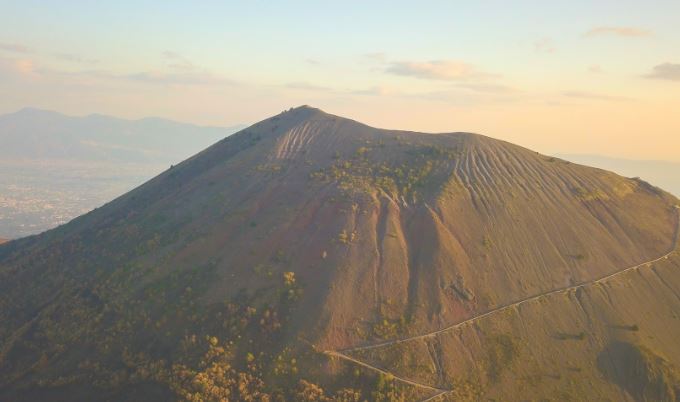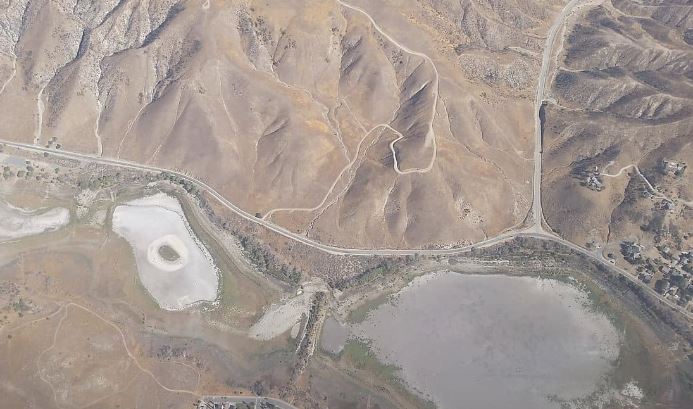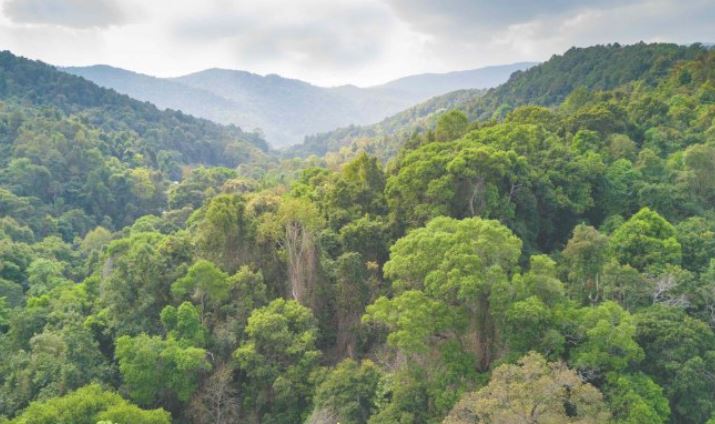In addition, volcanoes have done incredible things for us by helping to cool off Earth‘s excess interior heat. Imagine what would happen if that excess interior heat never had an outlet? Did you know, in Naples, Italy there are fertile stretches of land created by volcanic eruptions? The soil in that region is rich because of minerals from a volcanic eruption, minerals broken and weathered down by rain. Once absorbed by the soil, they became a steady supply of nutrients for plant life in that area. Isn’t that amazing?
If you liked the volcano facts we shared here, you’d be glad to know there is more where that came from. Check out the comprehensive list we’ve made of the top 50 cool volcano facts.
Volcanic winter can happen after a major volcanic eruption. It’s the decline in global temperatures due to volcanic ash and its droplets. This phenomenon obscures the sun and raises the Earth’s albedo, the measure of the diffuse reflection of solar radiation from the ground back to the space of incidence.
There are plans for “engineering volcanoes.”
Scientists have wanted to find a way to manage or even stop volcanic eruptions altogether. Unfortunately, up to this day, there are no successful developments, though theories and other plans are always constant. Experts knew that a regular volcanic eruption can be somewhat manageable, but looking at the bigger picture, a massive eruption can be very catastrophic. It can wipe out a huge population.
Experts are studying how to depressurize the magma chamber.
Although volcanic eruption forecasting is not 100% accurate, the latest technologies we have can reduce the risk of mishaps through evacuation, until an effective “engineered volcano” has transpired. Some of the plans and arguably the most promising include depressurization of the magma chamber and increasing the opening of the vent to reduce the energy of a potential eruption.
On our planet, volcanoes often sit in tectonic plates that are converging or diverging, and numerous of them are located underwater. Known as the submarine volcanoes, these underwater vents can also erupt magma like a regular volcano. According to estimates, Earth has over 1 million submarine volcanoes. They are thought to be widespread along the mid-Atlantic ridge located along the floor of the Atlantic Ocean.
There are different kinds of volcanoes.
To a normal person, the most common observation of a volcano is of a “pyramidal mountain,” scattering lava and harmful gases from its crater at the summit. However, this just represents one type of volcano out of the many. Each volcano can have its own unique features and can be more sophisticated than the others. Volcano facts you should take note of!
Geologists have grouped volcanoes into four main kinds: shield volcanoes, lava domes, cinder cones, and composite volcanoes. A shield volcano is normally composed almost entirely of fluid lava flows. Its name, “shield” resembles a shield of a fighter that’s lying on the ground. Furthermore, it’s a wide volcano with a shallowly sloping side.
Lava domes are built by slow eruptions coming from lava with high viscosity. Normally, lava domes form within the crater of a previous volcanic eruption or can even form independently. Similar to composite volcanoes, lava domes can create powerful eruptions. Although in general, the lava does not flow far from the originating vent.
Mount Fuji is a stratovolcano.
Also known as stratovolcanoes, composite volcanoes are tall cone-shaped mountains. Formed from various kinds of eruptions, the best examples of composite volcanoes are Japan’s Mount Fuji and Italy’s Stromboli. Standing more than 12,000 ft in height, Mount Fuji is the highest mountain in Japan.
Cinder cones came from the eruptions of scoria and pyroclastics.
Cinder cones came from the eruptions of scoria and pyroclastics. They are tiny pieces of highly vesicular dark-colored volcanic rock and clastic rocks made of rock fragments created by explosive volcanism. Arizona’s Sunset Crater and Mexico’s Parícutin are among the world-famous cinder cones.
Located north of Flagstaff, Arizona, Sunset Crater is the youngest in the group of volcanoes in the San Francisco volcanic field. On the other hand, the Parícutin volcano grew suddenly from the cornfield of local farmer Dionisio Pulido in 1943, bringing numerous scientific attention.
Olympus Mons is the tallest volcano in the known universe. Located on the planet Mars, Olympus Mons stands at 88,583 ft or more than three times the height of Earth’s tallest mountain, Mount Everest. This colossal volcano lies in the Tharsis region of the Red Planet.
Located in the Andes on Argentina–Chile border, Ojos del Salado is an active composite volcano. It is the highest active volcano on Earth at 22,615 ft. or 6,893 m. The members of the Polish expedition in the Andes, Jan Alfred Szczepański and Justyn Wojsznis, were the first recorded people to reach Ojos del Salado’s summit. Going to Ojos del Salado’s summit requires hiking mostly and the ascent to the top may vary depending on the side you take it from. Tours from Argentina will take approximately 13 to 15 days while the Chilean side takes about nine to 15 days, depending on the hiker’s capabilities.
The Philippines is home to over 250 volcanoes.
Nicknamed as “Pearl of the Orient Seas,” the Philippines is home to over 250 volcanoes. Its three major islands, Luzon, Visayas, and Mindanao, are flocked by thousands of international and local tourists each year to discover the beauty of its land formations. Located in Mindanao, the stratovolcano, Mount Apo is the highest point in the country at 2,954 m. or 9,692 ft. above sea level. Since Mount Apo’s last eruption is unknown, some call Mount Apo a dormant stratovolcano, while others believe it’s very much active.
Arguably the most famous volcano in the Philippines and one of the most beautiful volcanoes in the world, the Taal Volcano is a large caldera surrounded by Taal Lake. To be able to see its natural beauty close up, tourists must ride a boat, then hike up to its summit. If they’re not keen on hiking, tourists can ride a horse and hire a tourist guide.
Taal Volcano already erupted more than 30 times.
Taal Volcano is also the world’s smallest active volcano. With over 30 recorded historical eruptions since the modern era, its most recent eruption as of this writing was on January 12, 2020, damaging nearby cities and provinces around it. At least $70 million worth of establishments and resources were the amounted losses due to the eruption.
Interestingly and not known to many, you can set up a rare travel tour and swim in the viridian green water of “Taal Volcano’s mouth.” If you’re looking for a one-of-a-kind adventure, then Taal Volcano could be for you!
Mount Pinatubo is the second largest terrestrial eruption of the 20th century.
Another volcano from the Philippines, Mount Pinatubo is an active stratovolcano in Luzon. Pinatubo made its name known to the world for its massive eruption on June 15, 1991. It became the second-largest terrestrial eruption of the 20th century next to Alaska’s Novarupta that erupted in 1912.
Hawaii is another beautiful place that’s popular for its volcanoes. The island has five volcanoes and two of those are active, namely Mauna Loa and Kilauea. Moreover, the active shield volcano, Kīlauea is historically the most active of the five volcanoes that together form the magnificent Island of Hawaii. There is an inspiring must-watch I Shouldn’t Be Alive episode titled “Volcano
Mount Vesuvius is one of the most feared volcanoes.
The somma-stratovolcano, Mount Vesuvius (last erupted in March 1944) lies in the Gulf of Naples in Campania, Italy. One of its most historic eruptions dates back to AD 79 that ruined the Roman cities of Pompeii, Herculaneum, Oplontis, and Stabiae, including several other settlements. This volcano is one of the most feared across the globe. Aside from the fact that it’s extremely active and can produce powerful eruptions, it can bury an unbelievable value of infrastructure as well as risking up to 3 million lives within its area.
We create more CO2 emissions than volcanoes.
According to USGS or the United States Geological Survey, both the land and submarine volcanoes of our planet can produce roughly 200 million tons of carbon dioxide (CO2) each year. But compared to our industrial and automotive activities, it’s just a small percentage. Annually, this commercial industry causes over 20 billion tons of CO2 emissions worldwide. Volcano facts that should make you think.
Volcanoes form from rising magma.
Volcanoes on our planet normally form from rising magma. In detail, our Blue Planet’s crust is made of large sections of rock that we call tectonic plates. When a collision between two of Earth’s tectonic plates occurs, the friction created by the plates’ movement produces magma. Thus when the magma approaches the earth’s surface, a volcano is formed.
The hazard area around a volcano covers approximately a 20-mile radius.
In general, the hazard area around a volcano covers approximately a 20-mile radius. However, if a supervolcano such as the Yellowstone Caldera erupts, its ashes can spread hundreds of miles around the western half of the US with an instant devastating impact on the surrounding areas. Thankfully, even though Yellowstone Caldera is still active, experts believe that this volcano will not erupt for at least the next thousand years. And hopefully, future technology will know how to restrain a supervolcano. Yellowstone Caldera’s last eruption was over 600,000 years ago.


